7 Stellar Examples of Mobile Marketing Personalization
Brands running a mobile marketing personalization strategy earned 5x-8x ROI on their marketing spend.
And quickly outpace their competitors.
Why is personalized marketing so powerful?
Because users feel empowered, appreciated and very much understood when you use it. Personalization also has the added benefit of making it easier for consumers to locate the products most relevant to them.
Digital brands that can share a feeling of empathy with customers are going the farthest since buyers are out to purchases more than goods these days. Yes, also going into those shopping carts is a sense of belonging, comfort and convenience.
This post is going to look at how to construct a personalized marketing strategy for mobile users. We’ll dive into how to design personalized campaigns across lifecycle and behavior emails, push notifications, mobile interstitial banners, pre-filled forms and web content as well as web push notifications. Using 7 prime examples of successful e-commerce brands, you’ll soon be ready to share your total brand culture with your users across every mobile channel.
Let’s get personal!
What is Personalization Marketing?
Personalized marketing is the one-to-one strategy that brings the human element back to digital lifestyles.
Remembering someone’s name is crucial for showing them that you care about them, right? Our names have power. When we hear our names, we turn to face the speaker to hear what they have to say. Taking this psychological principle beyond the name-saying phase of the relationship continues the dialogue in a personal way that is key to retaining, engaging and converting customers. These interactions are the most rewarding for users and are highly sought-after.
Today’s best brands know that customers are eager to be treated uniquely - as often as possible. The goal here is to communicate in an attentive, conscientious and valuable fashion.
And since users are sticking with their mobile devices more than ever, that need for individual attention goes with them everywhere.
How can marketers use personalized marketing techniques to reach our mobile users?
- Using customer profile information (name, location, demographic specifics)
- Utilizing customer's preferred communication channel
- Remembering customer's past purchases
- Recommending purchases from what friends are buying
- Anticipating customer needs for future purchases
- Creating individualized content for each phase of the buyer journey, reinforcing brand engagement and values
With predictive machine learning becoming more powerful and connecting with CRM technologies, we can expect the reach and intelligence of marketing personalization to increase significantly in coming years.
Why Does Mobile Personalized Marketing Matter?
According to Kahuna, 86% of consumers say personalization influences their purchasing decisions. That’s practically everyone!
What’s more, 53% of consumers said that it’s equally important for retailers to recognize them as the same person across all channels and devices they use to shop. When we pair this statistic with the fact that mobile purchasing is steadily climbing every year, we see that it’s time to pay attention to mobile personalization marketing.
As Aden Hepburn of DigitalBuzzBlog shows in a revealing infographic about social influences in e-commerce, consumers want to buy goods in a consistent fashion only from those they trust most.
Are brands having success?
A VentureBeat survey found that 70-94% of marketers have achieved increases in key metrics by utilizing personalization. For example, GameStop earned a 41% increase in average order value. Microsoft decreased bounce rates by 35% and increased add-to-cart rates by a solid 10%.
Personalized campaigns are obviously valuable to both parties.
Now, let’s get specific on how to structure your campaigns effectively across different channels. This way you’ll know each and every relevant way to reach users.
#1 Behavioral Email - Nordstroms
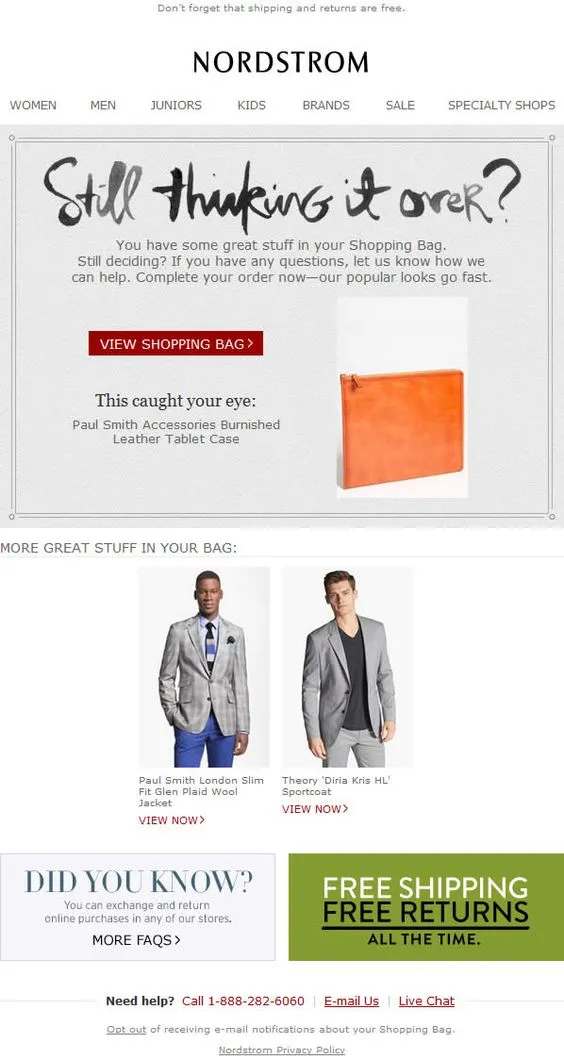
(Source)
Crazy fact: 205 billion emails are sent and received every 24 hours.
That’s a heap. The secret to getting your emails opened consistently lies in relevant messaging. But these days, personalized emails need more than a variable tag (Hi <name here>) to communicate relevance.
This Nordstrom behavioral email triggers after cart abandonment. Behavioral campaigns are crucial for engaging users and can be effective at spreading news about discounts, prompting sales or encouraging onboarding processes. In faded watercolors that say “fleeting,” subscribers are prompted to consider if it’s time to make that purchase they thought worthwhile a few days prior.
The luxury retailer does a great job of reminding users that “This caught your eye,” immediately involving the viewer with second person language to increase relevance. Listing the specific product is a great move as is displaying images of other items awaiting purchase. To see more sales and engagement, pinpointing with language and imagery speaks very loudly.
#2 Lifecycle Email - Tory Burch
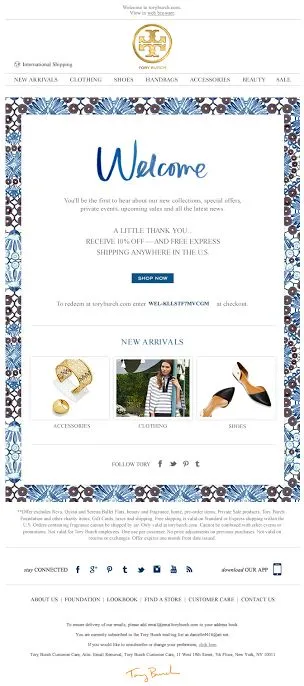
(Source)
We all love stats, so here’s more choice factoids: personalized emails receive a 6x greater transaction rate over standardized emails. And 50% of all emails worldwide are read from a mobile device, reports Loren McDonald of Silverpop.com who recently looked into IBM’s 2016 Email Marketing Metrics Benchmark study.
High-end womenswear label Tory Burch uses personalized lifecycle email to welcome new users to the brand experience. In a trusty penned font and loyalty-inspiring blue design, subscribers receive access to a 10% discount - a ready, actionable CTA to inspire action.
The pictures of “new arrivals” are a great touch since the stylish images and imagination are what really sells the luxury goods. With a touch of exclusivity and a great welcome offer, newcomers get immediate value from this ready-to-engage email. I’m sold!
#3 Mobile Web Page - Warby Parker
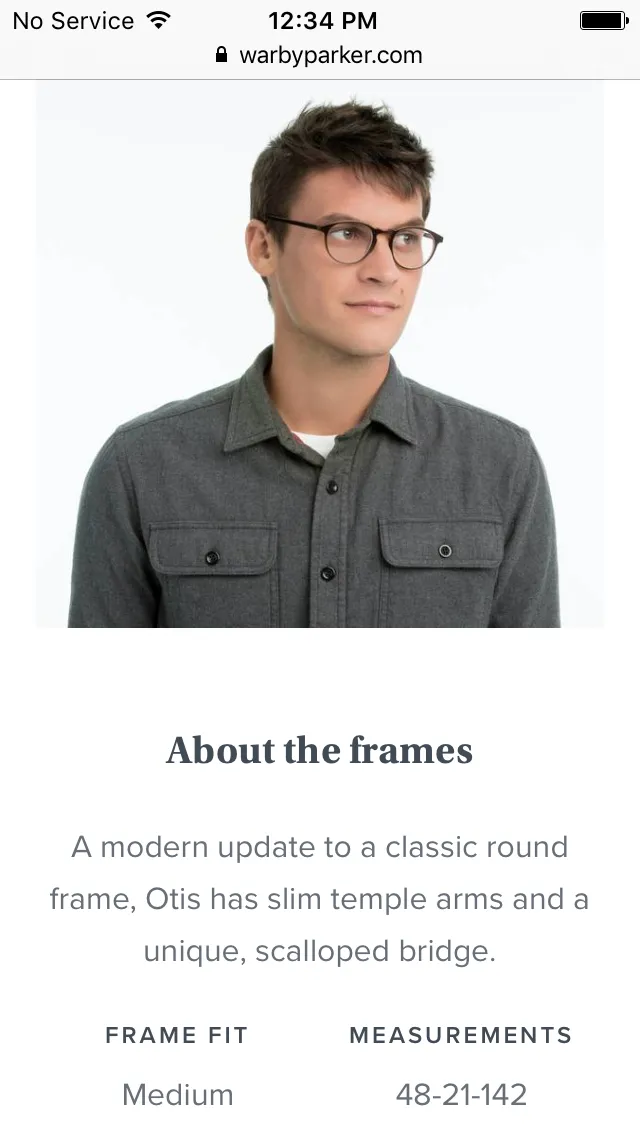
(Source)
A Hubspot study tells us that 76% of consumers think the most important factor in website design is the ability to help them find what they want. And MarketingProfs shares that brands with personalized marketing across web platforms see a 19% increase in sales.
Sounds great, I know. How can you get a piece?
First, make sure your web presence is responsive to ensure a quality, fast-loading UX. Second, focus on personalization marketing with dynamic content. Making sure to adjust web content to service specific user needs across segments is key for making sure consumers find what they need while on their mobile device.
The Warby Parker screenshot above shows us how simple and personalized it can be to own a new pair of eyeglasses. After clicking through from the “Men's” CTA (one of two) on the home screen, I clicked on the “Otis” icon and got this screen. It’s aesthetically clean for streamlined purchasing and provides a great rotating picture to help me with the decision. The best part is, since I’m a returning customer, it already has my measurements locked in and ready to go!
The eyewear brand even lets users upload a photo of themselves to the website to see which glasses look best. If the glasses don’t work in person, there’s free shipping back to the warehouse. Here’s a great example of how to encourage engagement and increase customer loyalties through easy, enjoyable shopping.
#4 Mobile Push Notifications - Gilt
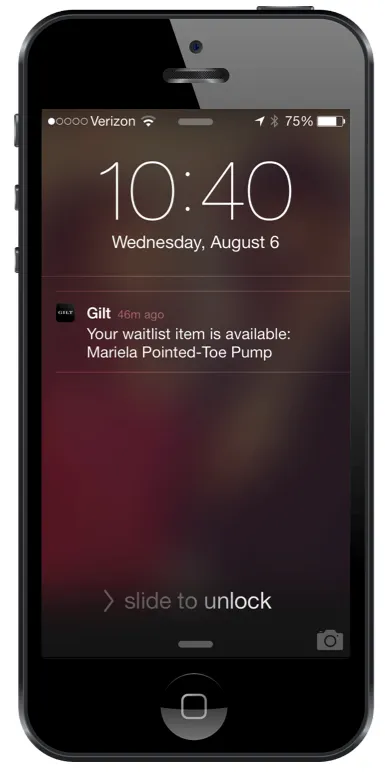
(Source)
More than 7 billion push notifications are sent just through iOS every single day. That’s one per person one the planet. Will one of those be going to your most engaged users?
Localytics asked mobile users what sort of push notifications were most relevant to them and 34% said that “special offers based upon my location” were best. What other types were appreciated?
Notifications that:
- Make life easier (see above)
- Encourage users
- Excite with offers
- Provide alerts or news
- Help users pick up where they left off (cart reminders)
- Keep users apprised of order status
Affordable luxury brand Gilt leads the way with e-commerce personalization strategies. Their mobile push notification is short and sweet, delivering timely information that improves customer experiences. The messaging speaks directly to users, inviting them with brand-name specifics to pursue their desired purchase. For example, this was a sold-out item that personalized marketing directly delivered to customers for a sale.
Gilt uses information based on past purchases to inform notifications as well as send recommended updates. Another feature of the e-commerce experience is never having to input your size again. Overall, the company makes it seamless to shop and pursue fashion with their brand. A definite way to increase revenue and loyal users.
#5 Mobile Interstitial Banner - Macy’s
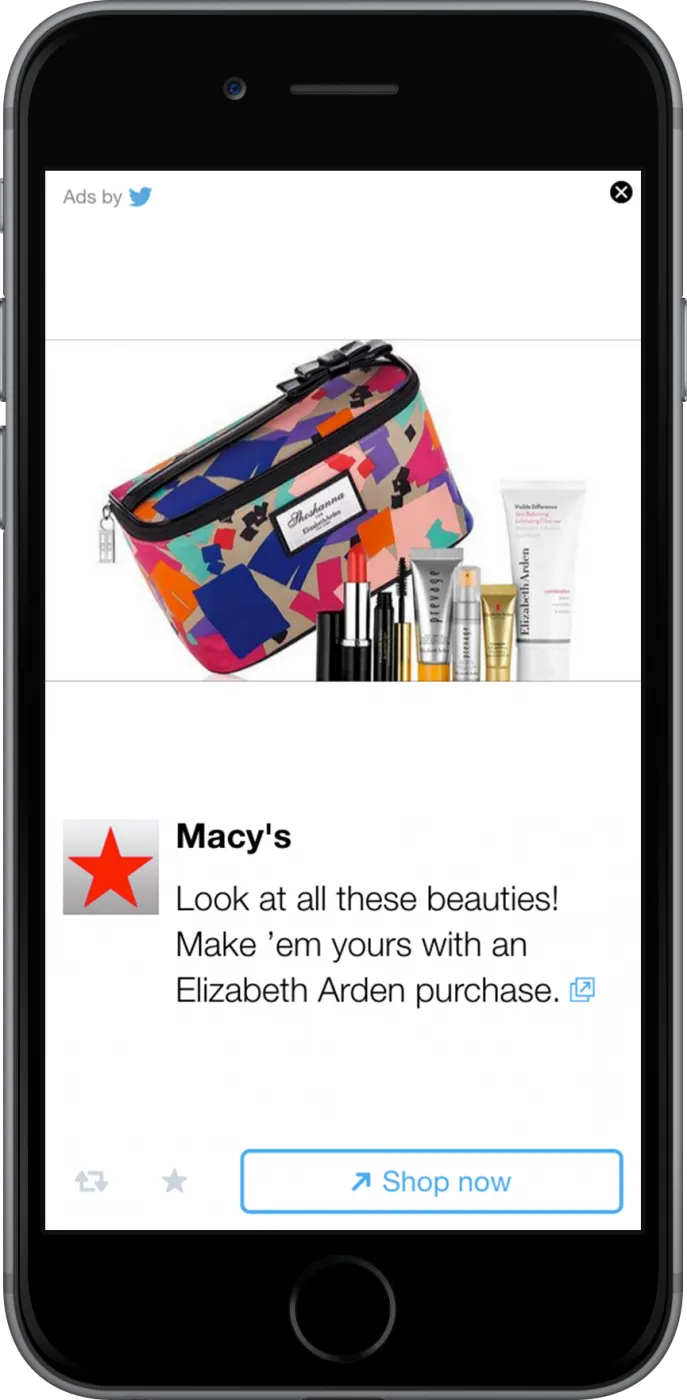
(Source)
Mobile interstitial ads really benefit from personalization. After all, they block out the entire mobile screen and demand attention away from app usage. If messaging isn’t relevant, app uninstalls can follow.
Macy’s online store uses Twitter profile info to promote special offers. Knowing the user is a woman and a Macy’s segment user, the retailer dangles fresh styles in front of app viewers. The conversational tone is to be commended as is the colorful layout. We could really use more of an incentive to buy, so in the future, we’d love to see a big CTA with actionable copy. And would it kill ya to use the word “Free?”
But most importantly, keep your channels aligned in their messaging. Personalization service Nectarom puts it nicely when describing the importance of omnichannel personalization:
“Consistency is the new black.”
#6 Pre-Fill Forms - Shein
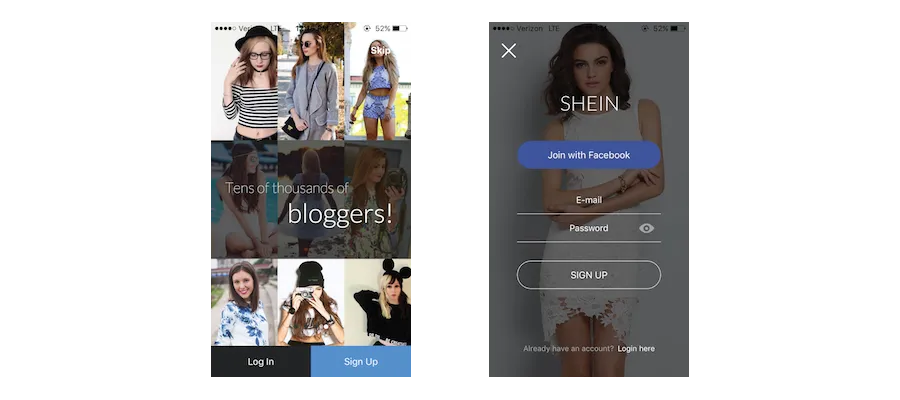
(Source)
Remember how we talked about remembering people’s names?
Making form fill boxes a no-brainer is a crucial aspect of personalized marketing campaigns. There’s no easier way to score points with users than to welcome them back to your brand with an easy login process. It also is an essential way to improve UX. Many a conversion is lost by making form fills too long or making it tedious for repeat users to log in.
Ladies fashion brand, Shein, makes it super simple to start shopping. As a first-time Shein-er, I was greeted by an exciting, social proof page with two easy-read CTAs. From here, all I need to do is sign in with Facebook (per usual) or enter two basic sets of info. Cheers to Shein for their super minimal design aesthetic and good use of pictures to keep me excited through sign up!
#7 Web Push Notifications - Beyond the Rack
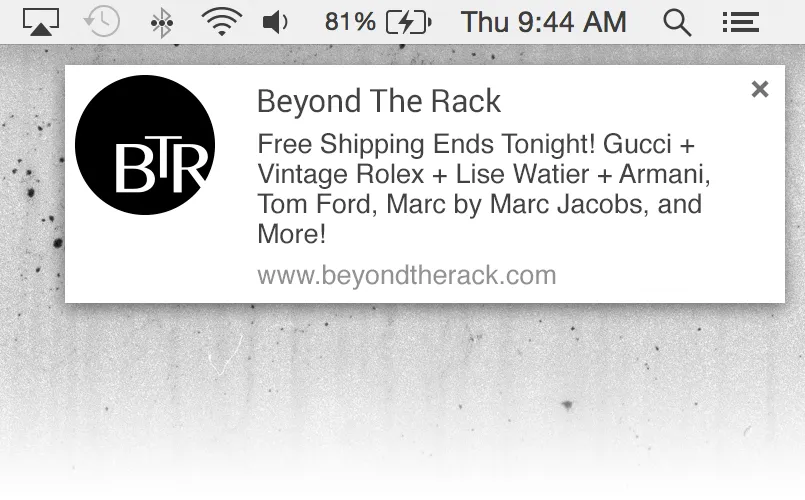
(Source)
Beyond the Rack makes the most of the small area afforded to their notifications box. Since they show up at the top right of home screens, web push notifications need to pack quite a punch. If not, they get disabled as an annoyance. When done right, they’re a great way to communicate discounts, updates and news to users.
“Free” is a power word - and there’s no better way to start a sentence in marketing! The e-commerce brand goes on to detail the value available with top-notch brands if we shop now. The active link below takes us right to the buying experience. To further personalize your marketing, send viewers to a personalized product landing page tailored to their specific needs. The more focused you are with your segments, the better your conversions, engagement and revenues.
In Closing.…
As you can imagine, our story doesn’t have a happy ending for the brand who failed to adopt to their mobile customer. With personalization taking off with advanced marketing automation suites, we can expect the best brands to outperform those who neglect this essential strategy. Will your business take advantage?
One area without personalization will get noticed. Be sure to include lifecycle and behavioral emails with valuable offers, push and web notifications that share relevant information, interstitial banners as well as a responsive web page.
Meeting customers on their level and always welcoming them with a brand experience shows you’ve spent time and energy to value them as an individual.